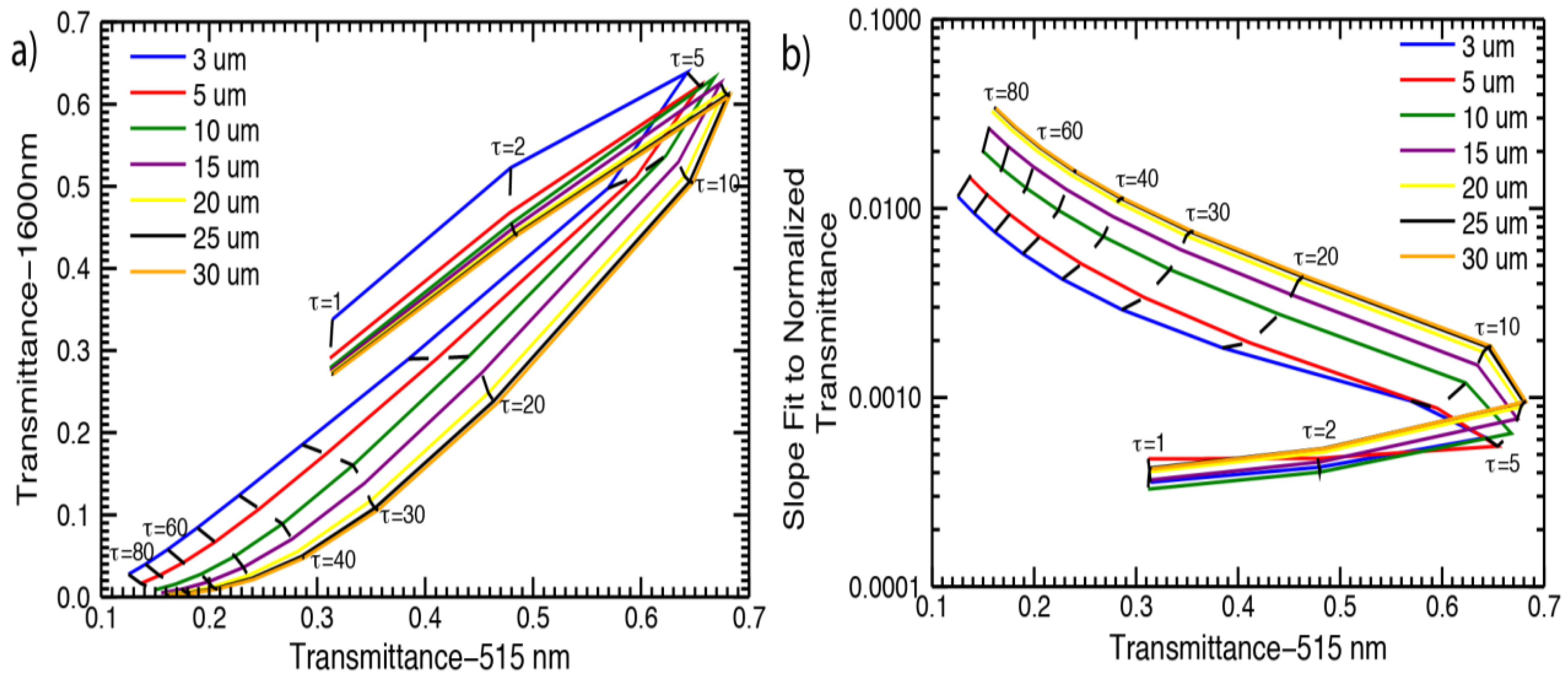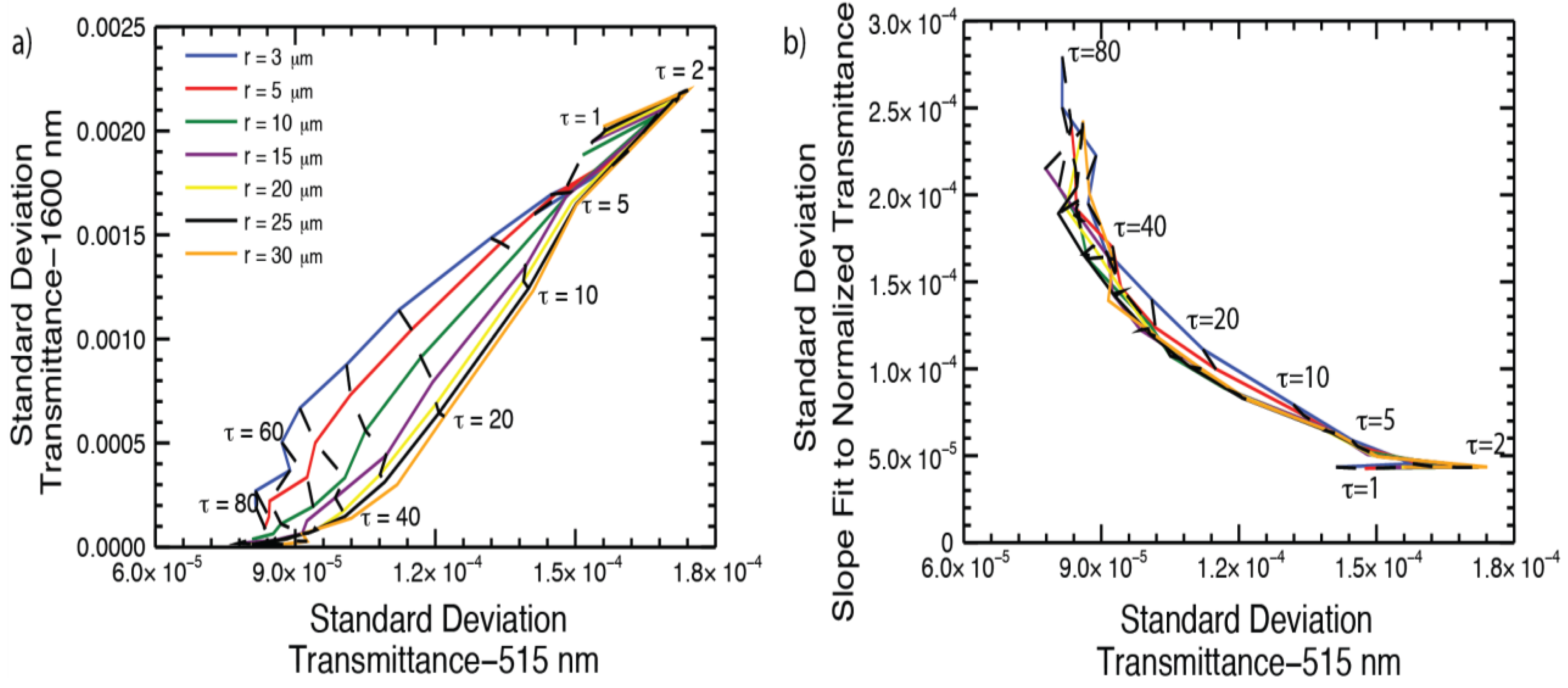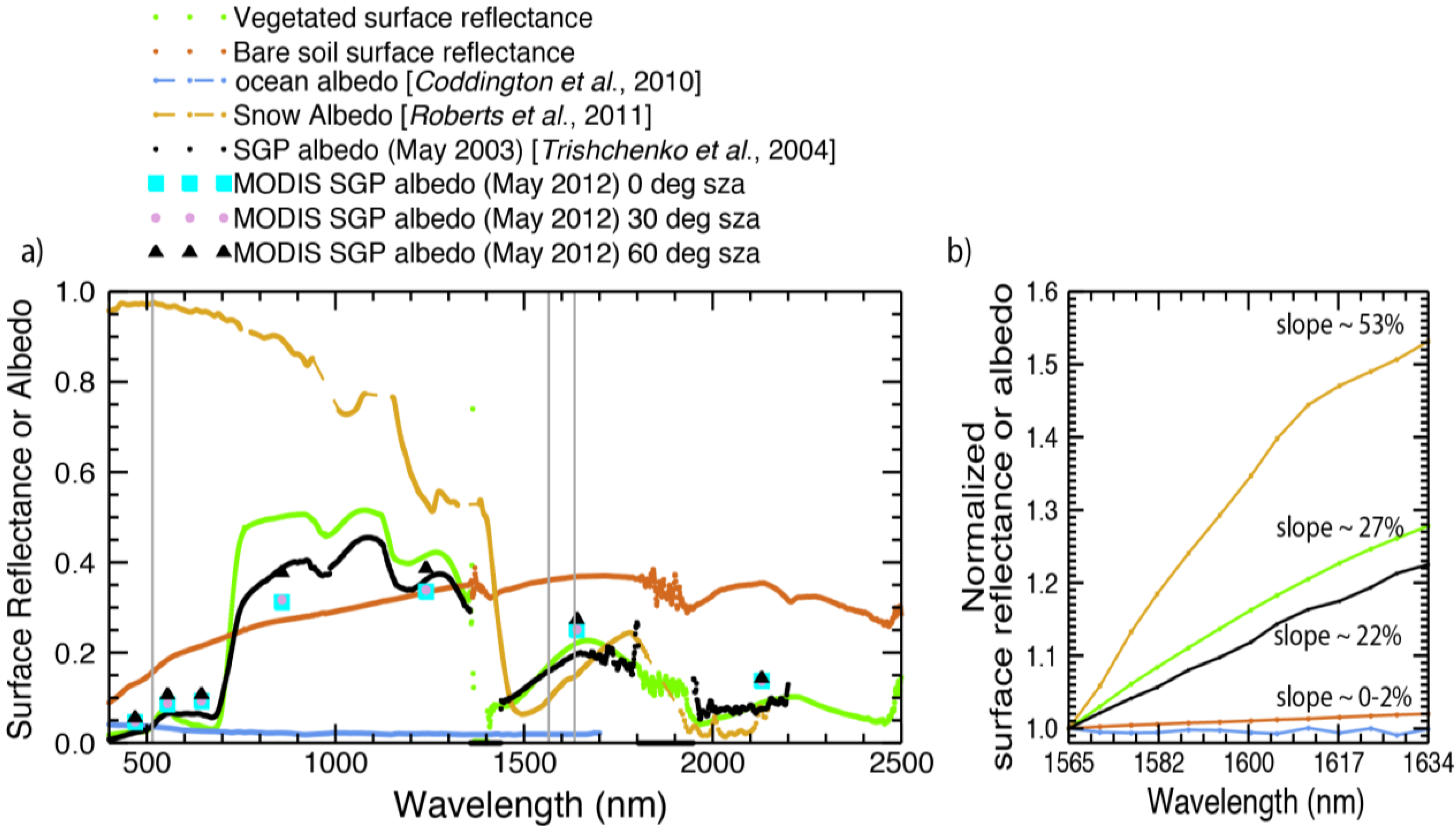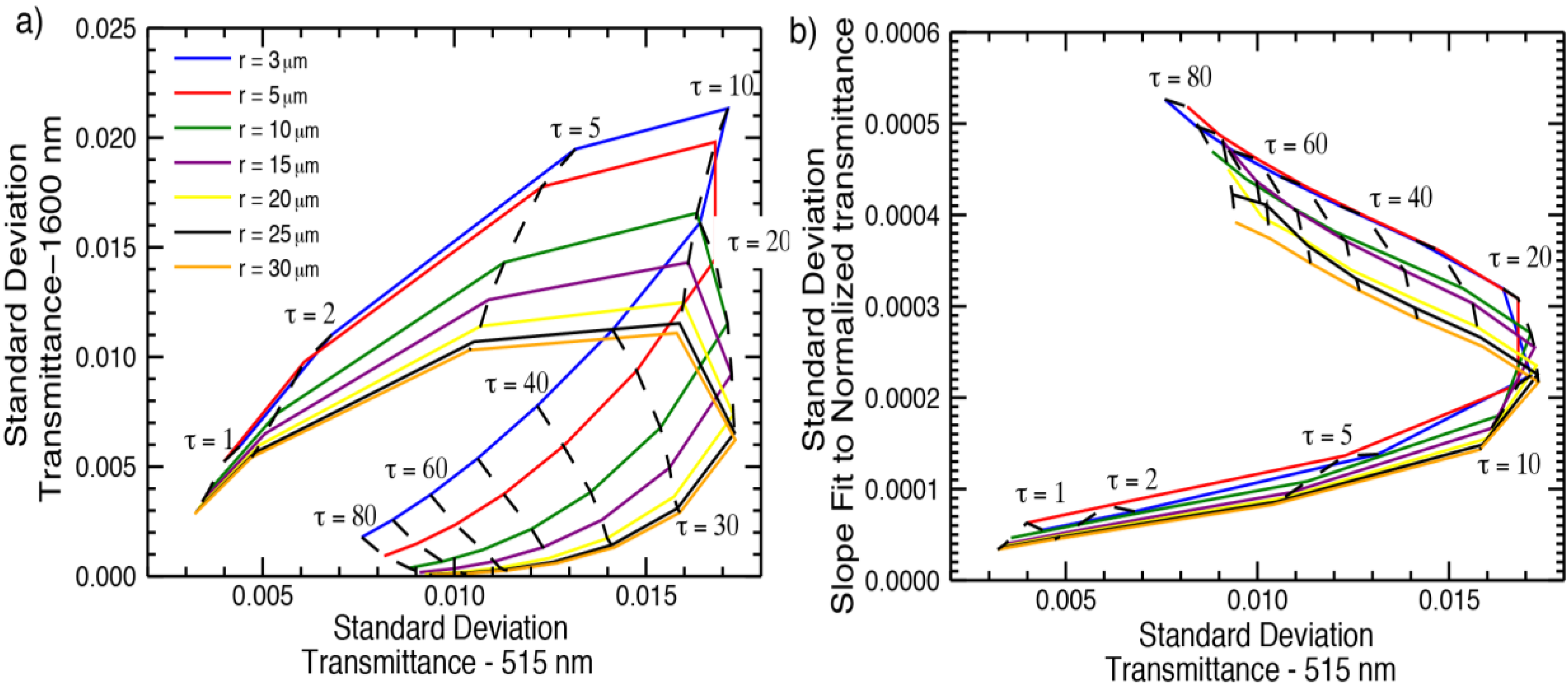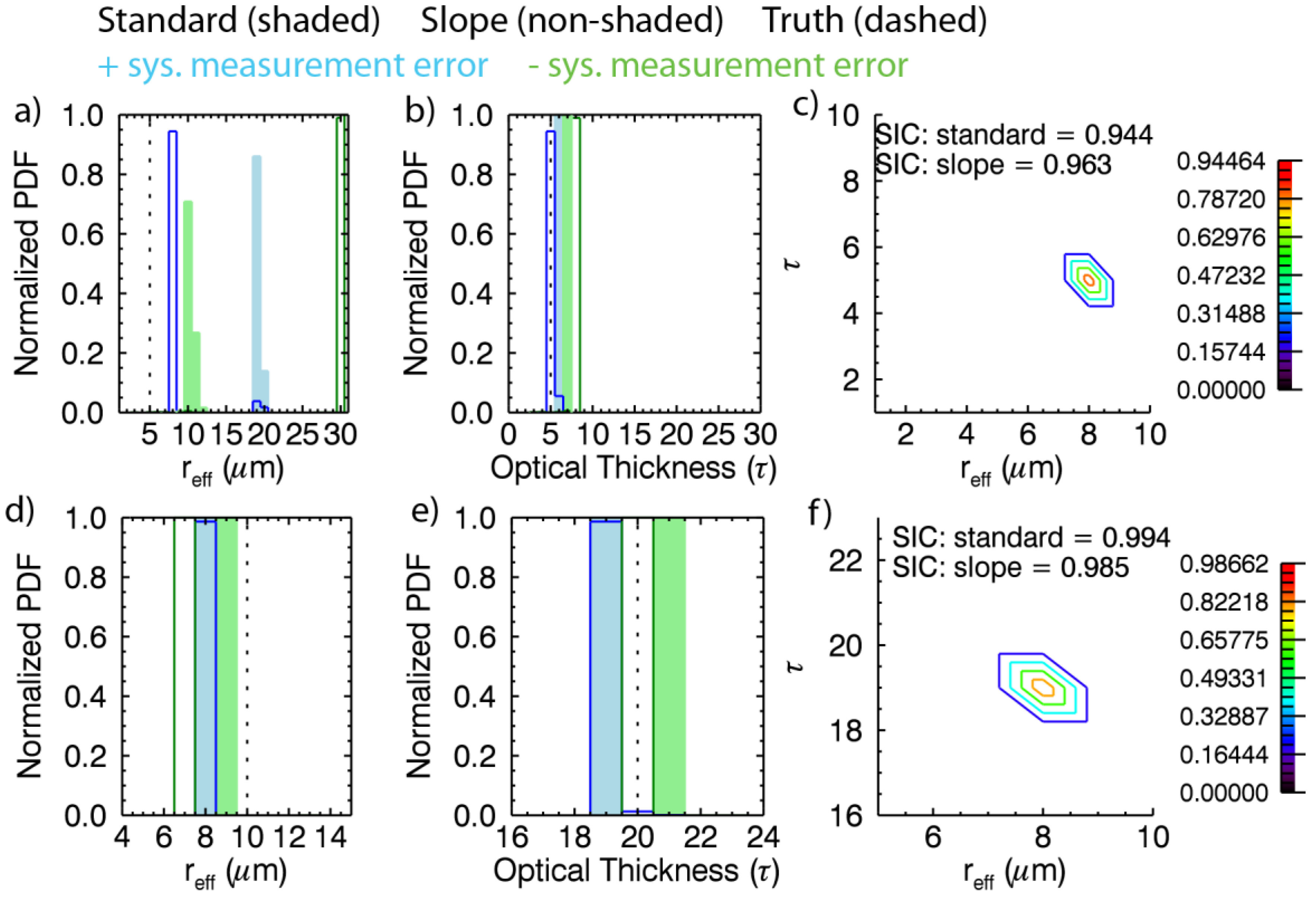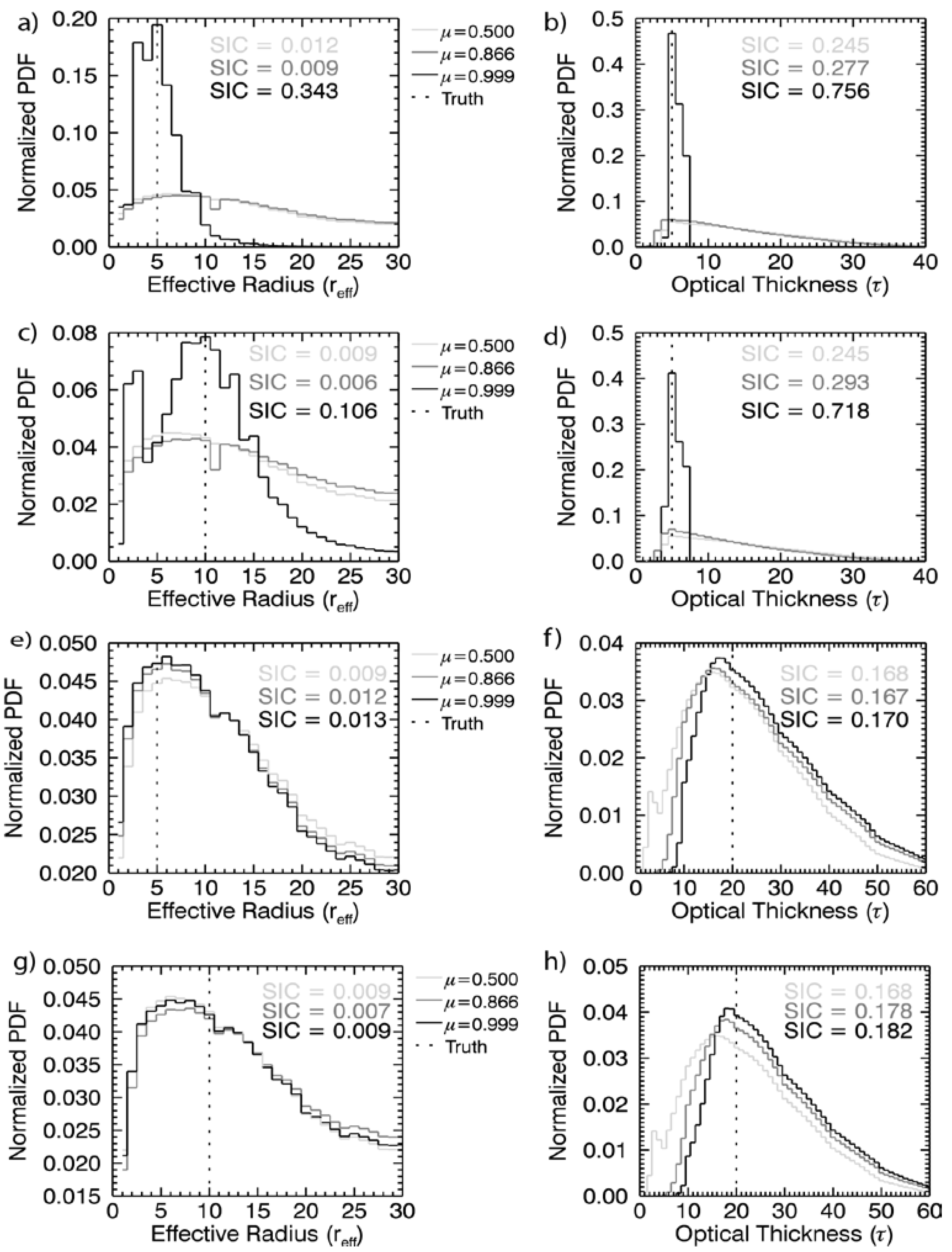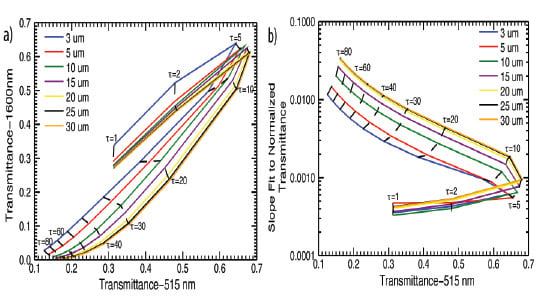1. Introduction
The radiative energy incident at the Earth’s surface comes from two sources, the Sun and the atmosphere. Clouds are the predominant atmospheric constituent impacting the flow of this radiant energy by absorption and by scattering some of the incoming shortwave (300–4,000 nm) radiation to space, and by emitting infrared radiation. Clouds may either cool or warm the surface depending on their altitude (temperature), thickness and composition. While much has been learned about global cloud coverage, cloud top heights, optical thickness and droplet size from passive remote sensing, a determination on whether clouds will enhance or counteract warming temperatures in a changing climate has not yet been achieved [
1].
Shortwave cloud reflectance results from scattering and absorption near cloud top. In contrast, transmitted cloud radiation, which can only be measured from below the cloud, interacts with all layers of a cloud [
2], providing a unique perspective not available from space. McBride
et al. [
3] highlight advantages to ground-based retrievals of cloud properties from optical transmittance compared to satellite retrievals based on reflected cloud radiance: more direct retrievals of cloud properties for deriving the surface radiative forcing, and the improved capability for studying cloud and aerosol interactions that comes with the increased temporal resolution of ground-based transmittance measurements.
Regardless of the perspective from which the remote measurements are made, the radiative impacts of the clouds depend upon their optical thickness and droplet effective radius, the ratio of the third to second moment of the particle size distribution (e.g., [
4]). Cloud properties can be derived from either reflectance or transmittance, but unlike reflected radiation, transmitted radiance is not a unique function of optical thickness. An additional disadvantage is the complete attenuation of transmitted radiance at large cloud optical thickness.
To improve the sensitivity of the retrieval to droplet effective radius, McBride
et al. [
3] developed a new algorithm for the retrieval of cloud optical properties based on the magnitude and shape of transmitted spectral radiance. Using error propagation methods, they investigated the impacts of measurement uncertainty on the retrieved cloud properties from the new spectral slope algorithm compared to the standard technique applied to cloud reflectance. They showed that the spectral slope method had smaller uncertainties over a broader range in cloud optical thickness values. However, McBride
et al. [
3] emphasized the need for a more formal error analysis treatment to investigate the impact of errors in the forward model inputs such as prescribed vertical cloud profile, thermodynamic phase, and underlying surface albedo on the retrieved cloud properties.
We employ the GEneralized Nonlinear Retrieval Analysis (GENRA) [
5,
6] to quantify the accuracy and precision of the cloud optical properties derived from measurements of transmittance. GENRA can be applied to retrieval methodologies based on least squares minimization techniques to derive the maximum likelihood solution and the Shannon information content [
7]. These diagnostics typically result from statistical inverse theory approaches, such as Bayes’ Theorem [
8]. Guided by these quantitative metrics of information content, we evaluate the slope and standard method under assumptions of realistic measurement errors and forward modeling input uncertainty in water vapor and surface albedo variability (from bare soil to purely vegetated surfaces) over a broad range in solar zenith angle.
Shannon information content (SIC) analysis of shortwave cloud retrievals has been applied in other recent studies. L’Écuyer
et al. [
9] and Cooper
et al. [
10] applied it across the visible through the infrared for the purposes of channel selection for retrieving water and ice cloud properties. Vukicevic
et al. [
5] used it to investigate the cumulative information gain in water cloud retrievals by adding spectral channels. Coddington
et al. [
6] expanded on this work and quantified the information content in hyperspectral cloud albedo measurements at nearly 400 wavelengths between 300 and 2,500 nm and also analyzed the retrieval wavelengths and weightings, and the cumulative retrieval information of a 5-wavelength cloud retrieval statistic. King and Vaughan [
11] investigated the information content in the retrieval of the vertical profile of cloud droplet effective radius, determining that hyperspectral cloud reflectance measurements offer improved details of cloud vertical structure over discrete-band instruments.
In this study we define the transmittance retrieval methods and wavelengths (
Section 2). We then introduce the modeling and analysis tools used in the study: the forward modeling calculations of transmittance (
Section 3.1) and the GENRA tool (
Section 3.2) used for investigating the random and systematic sources of measurement and forward modeling errors on the retrieved cloud properties (
Section 4). In our results (
Section 5), we demonstrate the expected cloud retrieval performance to these measurement and modeling errors (
Section 5.1,
Section 5.2), compute retrieval biases and Shannon information content over a broad range in cloud optical thickness and droplet effective radius (
Section 5.2.1), investigate non-Gaussian behavior in the retrieved distributions (
Section 5.2.2), and investigate the impacts of sun angle on the error characteristics and retrieved cloud products (
Section 5.2.3). A summary of the work is provided in
Section 6.
2. Surface-Based Cloud Retrieval Methods Based on Transmitted Radiation
In the visible and very near-infrared (approximately 350–1,000 nm) where liquid water does not absorb, cloud reflectance and transmittance depend primarily upon the cloud optical thickness through scattering. In the near-infrared, liquid water absorption increases and scales with the product of the bulk absorption coefficient and cloud droplet or ice crystal size. This forms the basis of the standard retrieval used in many operational satellite cloud retrievals to date ([
4,
12], and many others). Cloud optical thickness and particle size are not entirely separable in the inverse solution because there is a dependency on cloud optical thickness even at wavelengths where water absorbs. However, as clouds become increasingly optically thick, reflectance at non-absorbing wavelengths depends almost entirely on optical thickness while that at absorbing wavelengths almost entirely on droplet radius (see McBride
et al., Figure 3(a) of [
3]).
With surface measurements of zenith cloud
radiance, a one-to-one mapping of cloud optical thickness to transmittance does not exist [
3]. Downward diffuse radiance increases with optical thickness up to an optical thickness of about 5, beyond which it decreases. Droplet size has opposing impacts on cloud transmittance; a larger particle increases forward scattering but also absorbs more [
3]. The attenuation of the signal with increasing optical thickness and the ambiguity in the retrieved cloud properties due to the opposing impacts of scattering and absorption makes the retrieval of droplet effective radii more difficult with measurements of transmittance
versus reflectance.
We use a measurement-based definition of transmittance, T, defined as the ratio of transmitted zenith radiance (Itrans; units W·m−2·nm−1·sr−1) and normal incident solar radiance, μ0F0/π, at the top of the atmosphere (Equation (1)), where μ0 is the cosine of the solar zenith angle. The surface and the atmosphere below and above the cloud will contribute to the downwelling radiation through multiple reflections of the incoming radiation. Therefore, transmittance as defined here and used throughout the paper, is not solely determined by the cloud layer.
Figure 1(a) illustrates the non-monotonic behavior of transmittance measurements at a visible (515 nm) and a near-infrared wavelength (1,600 nm) as a function of cloud optical thickness (
τ) and droplet effective radii (
re). This forms the basis of the standard cloud retrieval method applied to spectral transmittances. One value of transmittance at 515 nm can arise from a cloud of two different optical thicknesses. In addition, for cloud optical thickness less than about five and effective radii greater than 3
μm, the lines of constant effective radius are clustered indicating relative insensitivity to droplet size. The calculations are performed for
μ0 = 0.75 and for a vegetated surface.
Figure 1.
(a) Look-up table of transmittance for standard method and (b) for slope method. Solid, colored lines are constant effective radius lines. Dashed, black lines are constant optical thickness lines. Calculations are for μ0 = 0.75 and a vegetated surface albedo.
Figure 1.
(a) Look-up table of transmittance for standard method and (b) for slope method. Solid, colored lines are constant effective radius lines. Dashed, black lines are constant optical thickness lines. Calculations are for μ0 = 0.75 and a vegetated surface albedo.
The impacts of surface albedo on transmittance are demonstrated through a direct comparison to McBride
et al., Figure 3(b) of [
3], which shows a look-up table of transmittance (at 515 nm and 1,628 nm) at the same solar angle, but for an ocean surface.
Note that the cloud optical thickness defined in the forward calculations used to generate the look-up tables plotted in
Figure 1 is treated as wavelength independent. Cloud optical thickness varies only weakly over the spectral range considered in this study, generating a retrieval uncertainty less than that due to measurement error, and thus is ignored. Further refinements of these methods and improvement in measurement accuracies may require the wavelength dependency in optical thickness to be taken into account in future studies.
To improve the sensitivity to droplet effective radius, McBride
et al. [
3] developed a cloud retrieval based on the transmittance at 515 nm and the slope of transmittance between 1,565 nm and 1,634 nm, normalized by the transmittance at 1,565 nm. Over this near-infrared range, because the bulk absorption coefficient of water is greatest at 1,565 nm, transmittance increases from 1,565 nm to 1,634 nm. The normalization of transmittance at one wavelength reduces the retrieval non-uniqueness to optical thickness and reduces systematic calibration errors. This forms the basis of the spectral slope cloud retrieval method applied to transmitted spectral radiance.
The retrieval wavelengths were carefully chosen (a) to be outside the strong gas absorption bands (predominantly water vapor) so differences between modeled and measured gas absorption do not impact the cloud retrieval, and (b) to exhibit linear behavior in transmittance over a broad range in cloud optical thickness and effective radius. Figure 5 of [
3] by McBride
et al. illustrates modeled transmittance at four different cloud optical thicknesses and two effective radii per optical thickness. The spectral dependencies in the transmittance are a factor of scattering and absorption by the cloud and by atmospheric molecular gases (discussed further in
Section 3.1 and references therein) and by the surface albedo. Cloud scattering and absorption are driven by the cloud optical properties; for example, Figure 4 of [
3] by McBride
et al. illustrates the wavelength dependence of two cloud optical properties: co-albedo, or one minus the single scattering albedo (indicative of absorption) and asymmetry parameter (indicative of the directional scattering).
Figure 1(b) illustrates the behavior of transmittance measurements at 515 nm and the slope fit to the normalized transmittance at 1,600 nm as a function of cloud optical thickness and droplet effective radius. The results shown in
Figure 1(b) were performed for a vegetated surface and
μ0 = 0.75. They can be directly compared to similar results (Figure 7 of [
3]) for an ocean surface to investigate the impact of surface albedo on transmittance.
Throughout the remainder of this work, we apply the definitions of McBride
et al. [
3] where the
standard retrieval refers to transmittance (defined per Equation (1)) at 515 nm and 1,600 nm. The
slope method refers to transmittance at 515 nm and the fit of the slope of normalized transmittance at 13 wavelengths between 1,565 nm and 1,634 nm (normalized by transmittance at 1,565 nm).
4. Representation of Error Sources
Uncertainty in the retrieved parameters can come from measurement errors and from errors in the input parameters to the radiative transfer model that is used to simulate the measurements. An additional source of errors is the approximations inherent to the radiative transfer model itself, such as plane-parallel assumptions. In this work, we investigate the error contributions of the first two sources.
In assigning the measurement pdf, we assume the simulated SSFR measurements are subject to a 3% systematic radiometric error offset [
3,
16] from the true value represented by the radiative transfer model result of the look-up table. We also assume the measurements are Gaussian distributed with a spectrally dependent variance of 0.03%–0.2% due to dark current noise. This approach is similar to Coddington
et al. [
6]. GENRA does not require assumptions of Gaussian distributed errors, but this is typically assumed with measurement errors.
We also investigate the impact of uncertainty due to natural variability in forward model inputs on the simulated transmittance. In this study, we derive the sensitivity of the transmitted cloud radiation to water vapor amount and to the magnitude and spectral shape of the underlying surface albedo only. The sensitivity in the transmittance to these variables will have spectral, cloud property, and solar angle dependencies. We report the sensitivities as standard deviations in the transmittance and the spectral slope of the transmittance relative to the baseline calculations discussed in
Section 3.1. The sensitivities are used in defining Gaussian distributions of the model pdfs.
Coddington
et al. [
6] (
Figure 1) computed the relative standard deviation (standard deviation divided by the mean) of cloud albedo due to a ±30% change in water vapor, ocean surface albedo, and profiles of state (pressure, temperature, and density). We utilize this same set of vertically resolved calculations to determine the impacts of total column water vapor variability on the simulated transmittance, as a function of cloud
τ and
re and wavelength.
Figure 2 shows the look-up table of the
standard deviation in transmittance due to ±30% water vapor variability and +3% systematic measurement error for (a) the standard method, and (b) the slope method.
Figure 2.
Standard deviation in transmittance as a function of
τ and
re for (
a) the standard method and (
b) spectral slope method due to a +3% systematic measurement error and ±30% change in water vapor. Calculations shown are for
μ0 = 0.92 and an ocean surface albedo. Plot details are as described in
Figure 1.
Figure 2.
Standard deviation in transmittance as a function of
τ and
re for (
a) the standard method and (
b) spectral slope method due to a +3% systematic measurement error and ±30% change in water vapor. Calculations shown are for
μ0 = 0.92 and an ocean surface albedo. Plot details are as described in
Figure 1.
The sensitivities provided in
Figure 2 are to be interpreted with respect to the transmittance values provided in
Figure 1. For example, transmittance values of 0.45 and 0.28 at 515 nm and 1,600 nm, respectively correspond to a cloud with optical thickness of approximately 20 and an effective radius of approximately 10
μm (
Figure 1(a)). The standard deviation in the transmittance for this
τ,
re pair due to ±30% variability in water vapor is approximately 0.0001 at 515 nm and an order of magnitude greater at 1,600 nm (
Figure 2(a)).
Transmitted radiation is dependent on the albedo of the surface surrounding the instrument and preliminary calculations by McBride
et al. [
3] suggested the retrieval of cloud droplet effective radius can vary by up to 11% depending on the magnitude and spectral shape of the surface albedo used as input for the radiative transfer calculations.
Figure 3(a) shows the large variability in magnitude and spectral shape of surface albedo and nadir surface reflectance between 400 nm and 2,500 nm (1,700 nm for ocean albedo example) for a variety of typical surface types. For a Lambertian surface, the spectral surface reflectance and albedo are essentially equivalent [
25,
26] and validation studies comparing the surface reflectance retrieved from satellite measurements using a Lambertian assumption to ground-based measurements show good agreement with residual standard errors of approximately 0.02 [
27].
Figure 3.
(a) Measured and retrieved spectral albedo and reflectance of common surface types from different geographic regions at different times. The data are from ground-based (vegetated and bare soil reflectances), airborne (ocean, snow, and vegetated Southern Great Plains (SGP) site in Oklahoma), and satellite measurements (vegetated SGP site; shown at three solar zenith angles—see text). Vertical grey lines denote the location of the 515 nm and 1,565 nm–1,634 nm retrieval wavelengths. (b) Spectral slopes of the albedo and reflectance between 1,565 nm and 1,634 nm, normalized by the respective albedo or reflectance at 1,565 nm.
Figure 3.
(a) Measured and retrieved spectral albedo and reflectance of common surface types from different geographic regions at different times. The data are from ground-based (vegetated and bare soil reflectances), airborne (ocean, snow, and vegetated Southern Great Plains (SGP) site in Oklahoma), and satellite measurements (vegetated SGP site; shown at three solar zenith angles—see text). Vertical grey lines denote the location of the 515 nm and 1,565 nm–1,634 nm retrieval wavelengths. (b) Spectral slopes of the albedo and reflectance between 1,565 nm and 1,634 nm, normalized by the respective albedo or reflectance at 1,565 nm.
The measured and retrieved surface albedo spectra shown in
Figure 3(a) were obtained over different times and geographical regions of the continental United States and from different ground, aircraft, and satellite platforms. The Southern Great Plains (SGP) May 2003 surface albedo spectrum (black curve) was retrieved from airborne SSFR measurements during the ARM Aerosol Intensive Observational Period [
19] and is the baseline surface albedo used in the forward modeling calculations of this work. The region around SGP is largely agricultural wheat fields that undergo intensive greening in the spring [
19]. The green vegetation signature near 550 nm and the near-infrared edge distinctive of vegetated surfaces are clearly seen. The ocean surface albedo (blue curve) was retrieved from airborne SSFR measurements above the northwestern Atlantic Ocean during the International Consortium for Atmospheric Research on Transport and Transformation (ICARTT) field campaign in 2004 [
28]. It has a uniformly low albedo, less than 0.04 between 350 and 1,700 nm. The snow albedo spectrum (yellow curve), also from airborne SSFR measurements, was acquired during the Arctic Research of the Composition of the Troposphere from Aircraft and Satellites (ARCTAS) field campaign in Alaska [
29,
30]. It exhibits near unity albedo values at visible wavelengths before changing to the magnitudes and spectral shape similar to those of vegetated surfaces at 1,600 nm. The bare soil (brown curve) and vegetated (green curve) reflectance spectra are from nadir measurements made with an Analytical Spectral Devices (ASD) spectrometer [
31]. Gaps in the spectra indicate regions of low detector sensitivity or low signal in gas absorption bands. The bare soil spectrum is relatively flat, in comparison to snow or vegetated surfaces and at near-infrared wavelengths greater than approximately 1,400 nm, soil has the greatest magnitude of albedo and reflectances for the surface types shown. Finally, discrete symbols (blue squares, pink dots, and black triangles) show the solar zenith angle dependency (0°, 30°, and 60° respectively) of surface albedo at the SGP site derived from bidirectional reflectance distribution function (BRDF) measurements made by the Moderate Resolution Spectroradiometer (MODIS) instrument [
32]. These discrete band surface albedos were computed from a 16-day climate model gridded BRDF product (MOD43C) obtained from 8 May to 1 June 2012. The MOD43C product provides the weighting parameters associated with the RossThick-LiSparse-Reciprocal BRDF model best describing the anisotropic reflection from the surface per each 500 m MODIS pixel [
32,
33,
34]. For a region encompassing the SGP site (36.64°N and 97.5°W), we obtained averaged values of these weighting parameters that describe the spectrally dependent anisotropic contributions to surface scattered light from components such as leaves and soil, as well as features (e.g., rocks and trees) that may shadow or obscure light [
34]. Albedo, the ratio of upwelling to total downwelling irradiance, is dependent on the direct and diffuse components of the downwelling irradiance.
Black-sky albedo, the direct beam directional hemispherical albedo, is the albedo in the absence of the downwelling diffuse component and thereby has a solar zenith angle dependency [
34].
White-sky albedo, the diffuse bihemispherical albedo, is the albedo in the presence of downwelling diffuse, isotropic light and in the absence of a downwelling, direct component. It is thereby a constant [
34]. The
blue-sky albedos (shown) are an interpolation between the black-sky albedo and the white-sky albedo and are dependent on the amount of diffuse skylight (
i.e., the isotropic diffuse fraction of the total illumination), which is itself dependent upon aerosol optical thickness [
34]. The fraction of diffuse skylight, which we prescribed to be 0.2, is a value that corresponds roughly to aerosol optical thickness at 550 nm of 0.2 to 0.3 for solar zenith angles between 0° and 60° [
34]. The results show that surface albedo increases with solar zenith angle [
35]. Despite the roughly 9 year period between the aircraft measurements [
19] and the MODIS results shown, the results show similar magnitudes and spectral shape in surface albedo for the SGP site. Because the MODIS albedo is a discrete-band product, it cannot provide information about the spectral shape in the 1,565 nm to 1,634 nm band. However, the MODIS albedo product can be used to independently constrain the surface type.
Figure 3(b) shows the slope fit of the surface albedo (or reflectance) in the 1,565 nm to 1,634 nm band normalized with respect to surface albedo (or reflectance) at 1,565 nm. The values range from 0%–2% (for ocean and bare soil, respectively) up to greater than 50% for snow. The bare soil albedo has the greatest magnitude at these wavelengths, but its spectral slope at these wavelengths is flat, similar to that of an ocean albedo. The normalized spectral slope of the baseline calculations (black curve) falls within the range of slopes for bare soil and pure vegetated surface, to be expected for an agricultural region.
If we assume no prior knowledge about surface type, the resulting standard deviations in transmittance to the broad range in surface albedo boundary conditions shown in
Figure 3(a) is so large that all retrieval solutions are equally likely (not shown). Hence, some independent prior knowledge of the surface type is required for the retrieval to converge. This knowledge could be satellite based. For example, one good candidate is the MODIS BRDF/albedo product, which has been shown to agree at six discrete bands (between 469 and 1,640 nm) to within 0.05 (typically 0.025) of airborne SSFR retrievals for a mixture of soil and vegetated surfaces, a range of solar zenith angles spanning 20° to 40°, and aerosol optical thickness from 0.24 to 0.32 [
14]. Therefore, in this work, we constrain our sensitivity study of surface impacts on transmittance to span bare soil to purely vegetated surface types.
In
Figure 4(a) we plot the surface albedo at 515 nm for linear mixtures of the bare soil and vegetated reflectance spectra shown in
Figure 3(a).
Figure 4(b) shows the fit of the spectral slope of the surface reflectance between 1,565 nm and 1,634 nm, normalized by surface reflectance at 1,565 nm for the same linear mixtures. In a linear mixture, the measured spectral variability in a region is assumed to be some combination of the spectral signatures of the distinct materials (or endmembers) in that region driven by the fractional abundances of the endmembers [
36]. Hence, the endmembers used in
Figure 4 are the bare soil and pure vegetated surface reflectances; the 100 data points along the x-axis are linear mixtures of these endmembers weighted by their fractional abundances in 1% increments (
data courtesy of Bruce Kindel). There is a positive linear relationship in surface reflectance at 515 nm and the fractional abundances of the endmembers (
Figure 4(a)) with lowest reflectance values (0.04) for the pure vegetated surface and higher reflectance values (0.16) for the pure soil surface. Near 1,600 nm, the fit of the spectral slope (in %) in the reflectance decreases with increasing fractional abundance of bare soil from approximately 28% to 2% as a second order polynomial (
Figure 4(b)).
Using the results of
Figure 4 and a 0.05 magnitude error in the surface albedo, we determine a range in the magnitude and spectral slope of surface albedo that will encompass surface types spanning bare soil to vegetated surfaces. First, the maximum and minimum values of surface albedo at 1,565 nm were obtained with a ±0.05 magnitude offset from the baseline value at 1,565 nm. Secondly, the minimum and maximum values of surface albedo at 1,634 nm were 2% and 28% greater, respectively, than the minimum and maximum values at 1,565 nm. Finally, the representative values of surface albedo at 1,600 nm were obtained by linear interpolation of the values at 1,565 nm and 1,634 nm.
Table 1 lists the minimum, maximum, and baseline surface albedo values at four wavelengths (515, 1,565, 1,600, and 1,634 nm) used in deriving the characterization of transmittance to surface type.
Figure 4.
(
a) The change in surface reflectance at 515 nm for 100 linear mixtures of bare soil and vegetated surface reflectances (from
Figure 3). (
b) The change in spectral slope (in %) of the surface reflectance between 1,565 and 1,634 nm, normalized by reflectance at 1,565 nm for the same linear mixtures. A 2nd degree polynomial fit (red) of the relationship is also shown.
Figure 4.
(
a) The change in surface reflectance at 515 nm for 100 linear mixtures of bare soil and vegetated surface reflectances (from
Figure 3). (
b) The change in spectral slope (in %) of the surface reflectance between 1,565 and 1,634 nm, normalized by reflectance at 1,565 nm for the same linear mixtures. A 2nd degree polynomial fit (red) of the relationship is also shown.
Table 1.
The minimum, maximum and baseline of the surface albedo at 515, 1,565, 1,600, and 1,634 nm used in forward modeling calculations to derive the standard deviation in transmittance at these wavelengths due to changing surface conditions. Baseline values are from measurements over a vegetated surface [
19] and are a subset of the full spectrum shown in
Figure 3 (black curve). The minimum and maximum values represent 0.05 magnitude errors and 2% to 28% change in spectral slope across the 1,565 nm to 1,634 nm wavelength range relative to the baseline (see text). These values are typical of errors in satellite retrievals of surface albedo and of the variability in bare soil and vegetated surface types shown in
Figure 3.
Table 1.
The minimum, maximum and baseline of the surface albedo at 515, 1,565, 1,600, and 1,634 nm used in forward modeling calculations to derive the standard deviation in transmittance at these wavelengths due to changing surface conditions. Baseline values are from measurements over a vegetated surface [19] and are a subset of the full spectrum shown in Figure 3 (black curve). The minimum and maximum values represent 0.05 magnitude errors and 2% to 28% change in spectral slope across the 1,565 nm to 1,634 nm wavelength range relative to the baseline (see text). These values are typical of errors in satellite retrievals of surface albedo and of the variability in bare soil and vegetated surface types shown in Figure 3.
| Wavelength (nm) | Minimum | Maximum | Baseline |
|---|
| 515 | 0.0377 | 0.1377 | 0.0379 |
| 1,565 | 0.1085 | 0.2085 | 0.1585 |
| 1,600 | 0.1096 | 0.2311 | 0.1773 |
| 1,634 | 0.1106 | 0.2669 | 0.1942 |
Figure 5 shows the look-up table of the
standard deviation in transmittance due to this variability in surface albedo and +3% systematic measurement error for (a) the standard method, and (b) the slope method relative to the baseline calculations. The calculations were performed for
μ0 = 0.5, 0.866, and 0.999. When compared to the standard deviation in transmittance due to water vapor variability (
Figure 2), we find that variability in surface albedo increases uncertainty in transmittance by two orders of magnitude at 515 nm, one order of magnitude at 1,600 nm for the standard method (comparing
Figure 2(a),
Figure 5(a) and about twice at 1,600 nm for the slope method (comparing
Figure 2(b),
Figure 5(b)).
Figure 5.
Standard deviation in transmittance as a function of
τ and
re for (
a) the standard method and (
b) spectral slope method due to +3% systematic measurement error and variability in surface albedo spanning bare soil to vegetated surface types. Calculations shown are for
μ0 = 0.866. Plot details are as described in
Figure 1.
Figure 5.
Standard deviation in transmittance as a function of
τ and
re for (
a) the standard method and (
b) spectral slope method due to +3% systematic measurement error and variability in surface albedo spanning bare soil to vegetated surface types. Calculations shown are for
μ0 = 0.866. Plot details are as described in
Figure 1.
6. Summary
In this study, we quantify the variance in transmittance resulting from ±30% variability in atmospheric water vapor content and spectral surface albedo spanning soil to vegetated surface types for a broad range of cloud optical thickness and droplet effective radius. The variance is quantified at a visible and near infrared wavelength and in the slope of the normalized transmittance over a near infrared wavelength channel (1,565 nm to 1,634 nm). Using an application based on general inverse theory called the GEneralized Nonlinear Retrieval Analysis (GENRA), the retrieved cloud optical properties using a new spectral slope method developed by McBride
et al. [
3] were compared to a standard method applied to reflectance, and the separate contributions from measurement and forward modeling sources were evaluated. The variability in surface albedo had the largest impact (greater than the variability in water vapor content or systematic and random measurement errors) on the accuracy and precision of cloud optical thickness and droplet effective radius based on measurements of ground-based transmittance.
The new spectral algorithm, which exploits the spectral shape of transmittance in the near infrared, is more accurate than the standard method for retrieving effective radius. For clouds with an optical thickness between 5 and 60 and droplet size less than approximately 20 μm, retrieval biases are within 2 μm and 5 for cloud droplet size and optical thickness, respectively. However, the retrieved distributions are, in most cases, imprecise due to the uncertainty in surface albedo, which may limit the applicability of the method. An exception is clouds with optical thickness greater than 5 but less than 10, effective droplet radii less than 10 μm, and overhead sun conditions. In the results shown, the coupling between cloud optical thickness and droplet effective radius distributions may be nonlinear resulting in differences in retrieval accuracy and precision compared to Gaussian distributions or assumptions of Gaussian behavior. The GENRA utility, or a similar analysis based on Monte Carlo ensemble which does not require Gaussian assumptions in the output statistics, is needed to accurately quantify these differences.
The results suggest ground-based measurements of transmittance, though more difficult because there is no one-to-one mapping between transmittance and optical thickness as occurs with measurements of cloud reflectance, can be utilized for cloud retrievals when the variability in surface albedo is constrained. A ground-based viewpoint allows for studies of clouds at higher temporal resolution than available from satellite. The MODIS BRDF/albedo product would be one good candidate to provide independent prior knowledge of surface albedo, potentially providing a constraint on surface type and thereby improving retrieval convergence. Future retrieval algorithms may consider a joint retrieval of cloud and surface properties because there is a clear influence of the surface properties on the downward radiation field below cloud. A new Shannon information content study may evaluate the feasibility of such a method.
This work did not investigate the impacts of snow-covered surfaces on the variability in transmittance. Snow covered surfaces have larger and more variable albedos at visible wavelengths [
37] than that investigated in this work for bare soil and purely vegetated surfaces. Nonetheless, this work provides a potential approach for investigating whether ground-based measurements of transmittance and the spectral slope retrieval method of McBride
et al. [
3] can provide valuable insight into high-latitude clouds over snow covered surfaces where satellite retrievals based on reflected radiation perform poorly.

